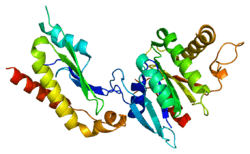References
- 1 2 3 GRCh38: Ensembl release 89: ENSG00000144867 - Ensembl, May 2017
- 1 2 3 GRCm38: Ensembl release 89: ENSMUSG00000032553 - Ensembl, May 2017
- ↑ "Human PubMed Reference:".
- ↑ "Mouse PubMed Reference:".
- ↑ Miller JD, Tajima S, Lauffer L, Walter P (Mar 1995). "The beta subunit of the signal recognition particle receptor is a transmembrane GTPase that anchors the alpha subunit, a peripheral membrane GTPase, to the endoplasmic reticulum membrane". J Cell Biol. 128 (3): 273–82. doi:10.1083/jcb.128.3.273. PMC 2120348. PMID 7844142.
- ↑ Legate KR, Falcone D, Andrews DW (Oct 2000). "Nucleotide-dependent binding of the GTPase domain of the signal recognition particle receptor beta-subunit to the alpha-subunit". J Biol Chem. 275 (35): 27439–46. doi:10.1074/jbc.M003215200. PMID 10859309.
- 1 2 "Entrez Gene: SRPRB signal recognition particle receptor, B subunit".
Further reading
- Bacher G, Pool M, Dobberstein B (1999). "The Ribosome Regulates the Gtpase of the β-Subunit of the Signal Recognition Particle Receptor". J. Cell Biol. 146 (4): 723–30. doi:10.1083/jcb.146.4.723. PMC 2156146. PMID 10459008.
- Strausberg RL, Feingold EA, Grouse LH, et al. (2003). "Generation and initial analysis of more than 15,000 full-length human and mouse cDNA sequences". Proc. Natl. Acad. Sci. U.S.A. 99 (26): 16899–903. doi:10.1073/pnas.242603899. PMC 139241. PMID 12477932.
- Yan W, Wang WL, Zhu F, et al. (2003). "Isolation of a novel member of small G protein superfamily and its expression in colon cancer". World J. Gastroenterol. 9 (8): 1719–24. PMID 12918107.
- Ota T, Suzuki Y, Nishikawa T, et al. (2004). "Complete sequencing and characterization of 21,243 full-length human cDNAs". Nat. Genet. 36 (1): 40–5. doi:10.1038/ng1285. PMID 14702039.
- Bouwmeester T, Bauch A, Ruffner H, et al. (2004). "A physical and functional map of the human TNF-alpha/NF-kappa B signal transduction pathway". Nat. Cell Biol. 6 (2): 97–105. doi:10.1038/ncb1086. PMID 14743216.
- Gerhard DS, Wagner L, Feingold EA, et al. (2004). "The Status, Quality, and Expansion of the NIH Full-Length cDNA Project: The Mammalian Gene Collection (MGC)". Genome Res. 14 (10B): 2121–7. doi:10.1101/gr.2596504. PMC 528928. PMID 15489334.
- Otsuki T, Ota T, Nishikawa T, et al. (2007). "Signal sequence and keyword trap in silico for selection of full-length human cDNAs encoding secretion or membrane proteins from oligo-capped cDNA libraries". DNA Res. 12 (2): 117–26. doi:10.1093/dnares/12.2.117. PMID 16303743.
- Li Q, Yan W, Cheng S, et al. (2007). "Introduction of G1 phase arrest in Human Hepatocellular carcinoma cells (HHCC) by APMCF1 gene transfection through the down-regulation of TIMP3 and up-regulation of the CDK inhibitors p21". Mol. Biol. Rep. 33 (4): 257–63. doi:10.1007/s11033-006-9007-9. PMID 17080297.
- Ewing RM, Chu P, Elisma F, et al. (2007). "Large-scale mapping of human protein–protein interactions by mass spectrometry". Mol. Syst. Biol. 3 (1): 89. doi:10.1038/msb4100134. PMC 1847948. PMID 17353931.
PDB gallery |
|---|
2fh5: The Structure of the Mammalian SRP Receptor 2go5: Structure of signal recognition particle receptor (SR) in complex with signal recognition particle (SRP) and ribosome nascent chain complex |








